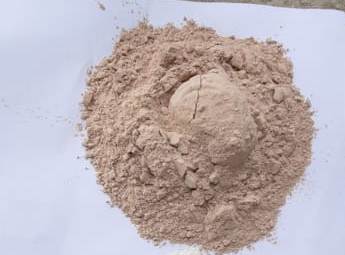Introduction to Barite in Oil and Gas
Barite (barium sulfate – BaSO₄) is a heavy, chemically inert mineral essential to oil and gas drilling. Thanks to its high density, non-toxicity, and ability to control well pressure, companies use it as a weighting agent in drilling fluids.
Globally, the oil and gas industry consumes over 80% of barite production, making it a critical mineral for safe and efficient drilling operations.

Key Functions of Barite in Drilling
-
Increases drilling fluid density to maintain pressure.
-
Prevents well blowouts and stabilizes boreholes.
-
Improves lubrication and cooling of drilling tools.
-
Carries drill cuttings to the surface, preventing blockages.
-
Minimizes formation damage, ensuring efficient oil extraction.
This article explores barite’s importance, types, reserves, processing methods, supply challenges, and market trends in oil and gas.
Why Barite Is Essential in Oil and Gas Drilling
1. Controlling Well Pressure and Preventing Blowouts
In drilling fluids, barite increases density and balances wellbore pressure. Consequently, it prevents uncontrolled fluid entry—known as blowouts—which can cause catastrophic failures.
2. Wellbore Stability and Structural Integrity
The weight of barite-infused mud supports the borehole walls, reducing the risk of collapse. This is especially critical in high-pressure formations.
3. Enhancing Lubrication and Reducing Friction
By reducing resistance between the drill bit and rock formations, barite improves operational efficiency. It also lowers wear on drilling equipment, extending bit life and cutting costs.
4. Transporting Drill Cuttings to the Surface
Barite boosts mud viscosity, enabling it to lift cuttings during circulation. This prevents sediment buildup and keeps drilling operations smooth.
5. Chemical Inertness for Formation Protection
Unlike alternative weighting materials, barite does not react chemically with drilling fluids. This protects the formation from contamination and ensures steady oil flow.
Types of Barite Used in the Oil and Gas Industry
Barite quality depends on specific gravity, purity, and intended application.
-
API-Grade Barite (4.2+ Specific Gravity) – Meets American Petroleum Institute (API) 13A standards; used in deep drilling.
-
OCMA-Grade Barite (4.1 Specific Gravity) – Certified by the Oil Companies Materials Association; common in onshore and offshore drilling.
-
High-Purity Barite – Contains minimal impurities; preferred for ultra-deep, high-pressure wells.
How Barite Forms in Nature
Barite occurs through hydrothermal, sedimentary, and residual processes, often alongside lead, zinc, and fluorite.
-
Hydrothermal Deposits – Formed from hot, barium-rich fluids that crystallize in veins; common in China, Mexico, and Morocco.
-
Marine and Evaporite Deposits – Precipitate from barium-rich seawater, creating thick sedimentary layers; found in India and the USA.
-
Residual and Vein Deposits – Occur in weathered limestone and fault zones; often yield high-purity material.
Global Barite Reserves and Production
1. China – The World’s Largest Producer
China leads global barite output, holding reserves exceeding 50 million metric tons. Production reaches 3.5–4.5 million metric tons annually, with over 80% used in drilling muds. Key mining provinces include:
-
Guizhou – Supplies nearly half of China’s barite and meets API standards.
-
Hunan – Serves domestic and export markets in North America, Europe, and the Middle East.
-
Guangxi – Expanding beneficiation facilities for both API and industrial-grade barite.
China’s advanced processing includes crushing, grinding, and beneficiation to remove impurities before achieving API 13A and OCMA certification.
2. India
Significant deposits lie in Andhra Pradesh and Rajasthan. India exports widely, especially to the Middle East and Asia.
3. United States
Mining occurs mainly in Nevada and Georgia, yet the U.S. imports more than 75% of its barite from China and Mexico.
4. Morocco
Supplies Europe and North America from large reserves in the Atlas Mountains.
5. Middle East (Iran, UAE, Saudi Arabia)
Increasing local production to meet regional drilling needs.
Processing and Quality Standards for Oil and Gas Barite
To meet industry specifications, barite undergoes:
-
Crushing and Grinding – Produces uniform particle sizes.
-
Beneficiation – Removes impurities such as iron and silica.
-
Certification – API 13A and OCMA compliance ensures correct density, fineness, and purity.
Challenges in the Barite Supply Chain
-
Dependence on China and India – Reliance on a few suppliers can drive price volatility.
-
Oil Price Fluctuations – Lower prices reduce drilling activity, cutting demand.
-
Environmental Regulations – Stricter mining controls in China and India influence production and export volumes.
Market Trends and Future Outlook
-
Deepwater and Offshore Growth – Expanding projects in the Gulf of Mexico, North Sea, and West Africa increase demand.
-
Domestic Resource Development – Nations like the USA and Saudi Arabia aim to reduce import reliance.
-
Recycling and Synthetic Barite – Gaining attention as cost-saving alternatives.
-
Emerging Markets – Africa, South America, and the Middle East show rising consumption.
Why Choose High-Quality Barite for Drilling?
Using premium API-grade barite ensures optimal drilling performance by offering:
-
Specific gravity above 4.2 for effective well control.
-
Low impurity content meeting API and OCMA standards.
-
Consistent supply for global projects.
Order High-Quality Barite Today
We supply 100% pure, API-compliant barite for worldwide drilling operations. Contact us for bulk orders, competitive pricing, and expert guidance.

